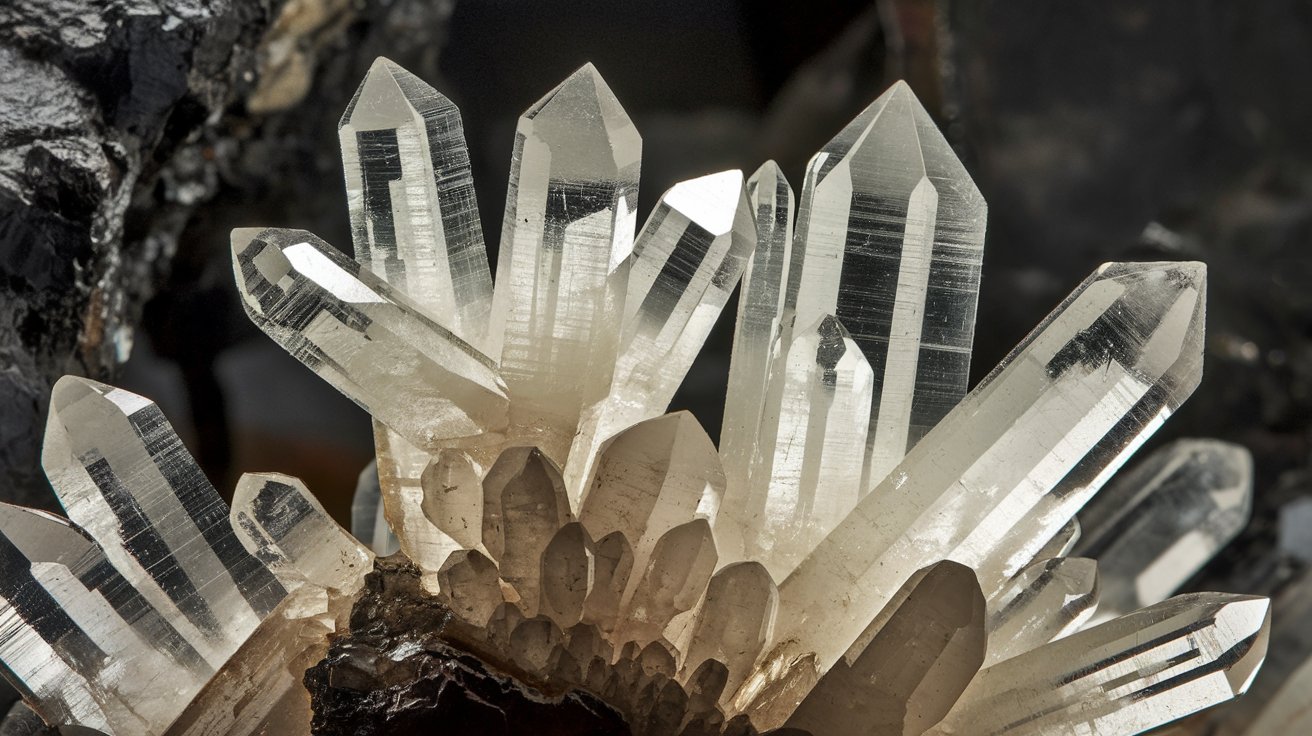
Ever wondered about the hidden gems of the mineral world? Meet Allactite, a rare arsenate mineral that stands out due to its unique properties and limited occurrence. With a chemical formula of Mn7(AsO4)2(OH)8, this mineral is a fascinating blend of manganese, arsenic, oxygen, and hydrogen. Allactite crystallizes in the monoclinic system, often forming elongated prisms or rosette-like aggregates. Its striking colors range from brown to dark purplish red, making it a visual treat for collectors. Found primarily in Sweden and New Jersey, USA, allactite forms in metamorphosed manganese deposits. Its strong pleochroism, showing different colors from different angles, adds to its allure. Dive into the world of allactite and uncover what makes this mineral a true marvel.
Key Takeaways:
- Allactite is a rare mineral with a unique crystal structure and fascinating optical properties. Its limited occurrence in specific geological settings makes it a prized specimen for collectors and researchers.
- Named after the Greek word for "to change," allactite's strong pleochroism and historical significance make it an intriguing subject for scientific study. Its rarity and conservation importance highlight the value of preserving geological sites and mineral collections.
What is Allactite?
Allactite is a rare mineral that has intrigued scientists and collectors alike. Its unique properties and limited occurrence make it a fascinating subject of study. Let's dive into some interesting facts about this mineral.
-
Chemical Formula: Allactite's chemical formula is Mn7(AsO4)2(OH)8. This means it contains manganese, arsenic, oxygen, and hydrogen.
-
Category: It falls under the arsenate minerals category, which includes minerals with arsenate ions (AsO4).
-
IMA Symbol: The International Mineralogical Association (IMA) symbol for allactite is "Ala".
-
Strunz Classification: In the Strunz classification system, allactite is classified as 8.BE.30, placing it among arsenate minerals with a specific crystal structure.
-
Dana Classification: According to the Dana classification system, allactite is categorized under 41.2.1.1, further detailing its position within arsenate minerals.
Allactite's Crystal Structure
Understanding the crystal structure of allactite helps in identifying and studying it. Here are some key details about its crystal system and related properties.
-
Crystal System: Allactite crystallizes in the monoclinic crystal system, known for its prismatic crystal class and specific space group (P21/a).
-
Unit Cell Dimensions: The unit cell dimensions are a = 11.03 Å, b = 12.12 Å, c = 5.51 Å, and β = 114°, with a Z value of 2.
-
Crystal Habit: It typically forms in elongated prisms, bladed, tabular, and rosette-like aggregates, showcasing its unique crystal habit.
Physical Properties of Allactite
The physical properties of allactite make it stand out among other minerals. Let's explore its color, hardness, and more.
-
Color: Allactite can range from brown to dark purplish red, brownish red, colorless to white, depending on its formation conditions.
-
Cleavage: It exhibits distinct cleavage along the {001} plane, indicating its crystal structure and potential cleavage patterns.
-
Fracture: The fracture of allactite is uneven, characteristic of brittle minerals.
-
Tenacity: Allactite has a brittle tenacity, meaning it breaks easily under mechanical stress.
-
Mohs Scale Hardness: With a Mohs scale hardness of 4.5, allactite is relatively soft.
-
Luster: Its luster is vitreous (glassy) but can appear slightly greasy on fracture surfaces.
-
Streak: The streak of allactite ranges from gray to faint brown, useful for identification.
-
Specific Gravity: The specific gravity is measured at 3.83 and calculated at 3.94, indicating its density relative to water.
Optical Properties of Allactite
Allactite's optical properties are quite fascinating and help in its identification and study.
-
Optical Properties: Allactite is biaxial (-), meaning it has different refractive indices for different crystal axes. The refractive indices are nα = 1.755–1.761, nβ = 1.772–1.786, and nγ = 1.774–1.787.
-
Pleochroism: It exhibits strong pleochroism, with colors ranging from blood-red (X), pale yellow (Y), to sea-green (Z).
-
2V Angle: The 2V angle of allactite is approximately 0°, indicating minimal birefringence.
Occurrence and Formation
Where and how allactite forms is crucial to understanding its rarity and significance.
-
Type Locality: The type locality of allactite is the Moss mine in Sweden, where it was first discovered in metamorphosed manganese deposits.
-
Occurrence: It is found in Sweden and New Jersey, USA, primarily in veins through metamorphosed manganese zinc ore deposits.
-
Formation: Allactite forms as a secondary mineral in the metamorphic process of manganese zinc ore deposits, indicating its secondary nature in geological formations.
Historical and Scientific Significance
Allactite has a rich history and has been the subject of numerous scientific studies.
-
Name Origin: The name "allactite" comes from Greek αλλάκτειν (allaktein), meaning "to change," referring to its strong pleochroism.
-
Rarity: It is considered a rare mineral due to its limited occurrence in specific geological settings and its secondary nature in mineral formation processes.
-
Mineralogical Significance: Allactite is significant in mineralogy due to its unique crystal structure and optical properties, making it an interesting subject for scientific study.
-
Scientific Studies: It has been studied extensively in scientific literature, with notable contributions including the crystal structure analysis by Moore in 1968.
-
Historical References: Allactite has been mentioned in historical mineralogical literature, such as Dana's System of Mineralogy, which provides comprehensive information on its classification and properties.
Collecting and Conservation
Allactite's rarity makes it a prized specimen for collectors and highlights the importance of conservation.
-
Collection Importance: Specimens are highly valued in mineral collections due to their rarity and unique characteristics, making them sought after by collectors and researchers alike.
-
Geological Context: The occurrence of allactite in metamorphosed manganese zinc ore deposits provides valuable insights into the geological processes that shape these deposits and the conditions under which secondary minerals form.
-
Conservation Status: As a rare mineral, allactite is not typically considered a conservation concern, but its limited occurrence highlights the importance of preserving geological sites and mineral collections for future scientific study.
The Fascinating World of Allactite
Allactite is a rare gem in the mineral world. Its chemical formula, Mn7(AsO4)2(OH)8, showcases a unique blend of manganese and arsenic. Found primarily in Sweden and New Jersey, this mineral forms in metamorphosed manganese zinc ore deposits. Its monoclinic crystal system and distinct cleavage make it a standout. With a Mohs hardness of 4.5, it's relatively soft but still captivating. The pleochroism of allactite, shifting from blood-red to sea-green, adds to its allure. Collectors and researchers prize it for its rarity and unique properties. Understanding allactite provides insights into geological processes and the formation of secondary minerals. Its specific gravity of 3.83 and vitreous luster further highlight its distinct characteristics. Allactite's story, from its discovery in the Moss mine to its place in collections, underscores its importance in mineralogy.
Frequently Asked Questions
Was this page helpful?
Our commitment to delivering trustworthy and engaging content is at the heart of what we do. Each fact on our site is contributed by real users like you, bringing a wealth of diverse insights and information. To ensure the highest standards of accuracy and reliability, our dedicated editors meticulously review each submission. This process guarantees that the facts we share are not only fascinating but also credible. Trust in our commitment to quality and authenticity as you explore and learn with us.


